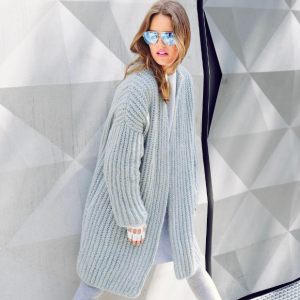
Patent elastic - three-dimensional pattern. Its distinctive feature is that it looks the same on both the right and left sides. It is perfect for knitting fashionable oversized cardigans.
How to knit patent elastic
Patent gum is the basis for many famous relief patterns. It consists of alternating knit and purl stitches, so it is suitable for both experienced and beginner needlewomen. There are two main ways to do this:
- The knitting needle should not be inserted into the loop itself on the left knitting needle, but into the loop that is located under it. After this, the loop located above is thrown off the knitting needle and unraveled into one row.
- Removing the loop together with a yarn over without knitting it. In the next row, this loop is knitted together with the yarn over.
Some tips for implementation:
- Be sure to make a test sample measuring 10*10 cm or 15*15 to determine the required number of loops.
- For a more voluminous pattern, it is better to choose thick knitting needles and yarn.
- Don't knit too tightly.
- Carefully monitor the knitting process. Mistakes made are extremely difficult or even almost impossible to correct. We'll have to let everything go.
- You should not choose patent elastic bands for tying the lower part of sleeves or straps. They are more often used as decorative elements, since they retain their shape very poorly and stretch greatly.
Classic cardigan with patent elastic

Necessary materials:
- 600 g of yarn (140 m/50 g);
- Knitting needles number 6.
Back
Cast on 79 stitches on the needles. Next, continue knitting with a patent elastic band. The length of the section knitted with this pattern should be 30 cm. Afterwards, knit all the rows of the LP. In the first of them add 5 loops.
After knitting another 36 r, make raglan bevels, decreasing 1 loop. Then cast off 1 stitch 19 times in even rows.
When the section knitted with stock rows reaches a length of 27 cm, begin designing the neckline. To do this, close 34 loops located in the center of the row. Knit the remaining side parts separately. From the inner edge in the next even row, cast off 2 loops, decrease 2 loops 1 time, 1 loop each time.
In total you need to knit 74 rows or 29.5 cm in stockinette stitch. After this, bind off all remaining loops.
Left shelf
Cast on 70 stitches. In the next row, remove the CP, knit 65 loops with a patent elastic band, 1 LP, 1 slip as an IP, 1 LP, 1 CP.
In this way, knit 30 cm. In the next row, count the outer 11 loops and leave them, knit the remaining 59 loops as LP.
At the same time, begin decreasing for the neckline. To do this, cast off 1 loop each time, then cast off 1 loop in even rows (36 times).
On the right side, make a raglan bevel similar to the back.
Knit 29.5 cm in stockinette stitch and bind off the remaining 2 stitches. The right front is knitted similarly to the left, but in a mirror image.
Sleeves
Knit both sleeves at the same time. Cast on 43 stitches on the knitting needles for each sleeve and continue knitting in stockinette stitch.
Make the bevels of the sleeves by adding 8 loops once every 16 rows. After this, 59 loops should remain on the knitting needles.
Having knitted 31 from the beginning, continue knitting with a patent elastic band. Knit them 15 cm, then decrease 2 loops 1 time and 2 loops 9 times in each 6th row.
After the shoulder bevels, knit another 15 cm and bind off all the loops.
Assembly
Sew shoulder seams. Cast on the loops that were left on the bar and continue knitting according to the pattern. Knit in this way to a length of 43 cm. After this, remove the loops again and connect them, focusing on the middle of the back, using a knitted seam.
Sew the placket to the neckline and neckline edges. Sew side seams and sleeves.


 0
0





